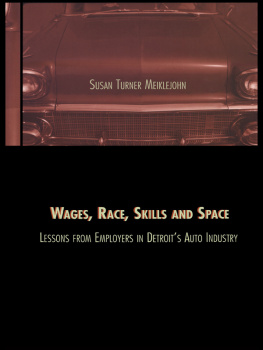WAGES, RACE, SKILLS AND SPACE
CONTEMPORARY URBAN AFFAIRS
VOLUME 5
GARLAND REFERENCE LIBRARY OF SOCIAL SCIENCE
VOLUME II70
CONTEMPORARY URBAN AFFAIRS
RICHARD D.BINGHAM, series Editor
LOCAL ECONOMIC DEVELOPMENT POLICY The United States and Canada by Laura A.Reese
BEYOND EDGE CITIES by Richard D.Bingham, William M.Bowen, Yosra A.Amara, Lynn W.Bachelor, Jane Dockery, Jack Dustin, Deborah Kimble, Thomas Maraffa, David L.McKee, Kent P.Schwirian, Gail Gordon Sommers, Howard A.Stafford
NEIGHBORHOODS, FAMILY, AND POLITICAL BEHAVIOR IN URBAN AMERICA by Yvette M.Alex-Assensoh
GOVERNING METROPOLITAN AREAS Response to Growth and Change by David K.Hamilton
THE COLLABORATIVE CITY Opportunities and Struggles for Black and Latinos in U.S. Cities edited by John J.Betancur and Douglas C.Gills
THE ART OF REVITALIZATION Improving Conditions in Distressed Inner-City Neighborhoods by John W.Zielenbach
WAGES, RACE, SKILLS AND SPACE Lessons from Employers in Detroits Auto Industry by Susan Turner Meiklejohn
MINORITY POLITICS AT THE MILLENNIUM edited by Richard A.Keiser and Katherine Underwood
WAGES, RACE, SKILLS AND SPACE
LESSONS FROM EMPLOYERS IN DETROITS AUTO INDUSTRY
SUSAN TURNER MEIKLEJOHN
The Maxine Goodman Levin College of Urban Affairs at Cleveland State University
GARLAND PUBLISHING, INC.
A MEMBER OF THE TAYLOR & FRANCIS GROUP NEW YORK & LONDON 2000
Published in 2000 by
Garland Publishing, Inc.
A member of the Taylor & Francis Group
29 West 35th Street
New York, NY 10001
This edition published in the Taylor & Francis e-Library, 2005.
To purchase your own copy of this or any of Taylor & Francis or Routledges collection of thousands of eBooks please go to www.eBookstore.tandf.co.uk.
Copyright 2000 by Susan Turner Meiklejohn
All rights reserved. No part of this book may be reprinted or reproduced or utilized in any form or by any electronic, mechanical, or other means, now known or hereafter invented, including photocopying and recording, or in any information storage or retrieval system, without permission in writing from the publishers.
Library of Congress Cataloging-in-Publication Data
Meiklejohn, Susan Turner.
Wages, race, skills and space: lessons from employers in Detroits auto industry/Susan Turner Meiklejohn.
p. cm(Garland reference library of social sciences; v. 1170.
Contemporary urban affairs; v. 5)
Includes bibliographical references and index.
ISBN 0-8153-2844-3 (alk. paper)
1. Discrimination in employmentMichiganDetroit. 2. Afro-American automobile industry workersMichiganDetroit. I. Title. II. Garland reference library of social science; v. 1170. III. Garland reference library of social science. Contemporary urban affiars; v. 5.
HD4903.3.A82 U65 2000
331.6396073077434dc21 99051638
ISBN 0-203-01155-4 Master e-book ISBN
For my guys Alec Meiklejohn and Emile Haynie who bring me such comfort and joy
Series Editors Foreword
Susan Turner Meiklejohns Wages, Race, Skills and Space: Lessons from Employers in Detroits Auto Industry is an important study of wage and employment differences between blacks and whites in an urban economy. The book presents the results of a Detroit-based research endeavor which sought to understand the role of employer practices, geography, job skills, and the characteristics of workers in explaining economic disparities between black and white workers.
In this qualitative study, Meiklejohn designed a case-match format to be able to compare 13 black-owned firms and 13 white-owned firms. Firms were matched by technology used, location, size, and product produced. She conducted 52 interviews at these firms. The length of the interviews ranged from one to five hours with a mean of 90 minutes. Interviews were conducted with CEOs and with floor supervisors who had day-to-day contact with entry-level workers.
Meiklejohn finds that black employers are more likely to hire black workers, but both black and white employers with largely black workforces pay significantly lower wages than employers with largely white workforces. She also finds what appears to be discriminatory hiring practices in largely white suburban firms and harassment of black workers in the suburbs. However, the labor-force problems of blacks are complex. For example, it is extremely difficult for urban residents without cars to adequately search for higher-paying jobs in the suburbs especially when employers recruit by posting signs in their windows or by word of mouth. Meiklejohn concludes with policy recommendations to reduce hiring discrimination.
Richard D.Bingham
Acknowledgments
Sheldon Danziger provided detailed and helpful comments to an earlier version of this book. John Nystuen, Mary Corcoran, and Reynolds Farley also provided excellent feedback on my first draft. Harry Holzer and Chris Tilly shared early versions of their work with me and they, along with Sanders Korenman, very much aided my understanding of the issues I address here.
Information from chapters was previously published in a different form as Barriers to a Better Break: Employer Discrimination and Spatial Mismatch in Metropolitan Detroit. Journal of Urban Affairs 19, 2:123141.
List of Tables
Firm Profiles
Respondent Profiles
Average Wages by Race of Employer and Employer Location
Sample Job Wages and Benefits
Perceived Skill Differences
Sample Job and Worker Skill Characteristics
Introduction
In the years between World War II and the 1960s, African Americans made considerable gains relative to whites in terms of labor-force participation, employment rates, occupational distribution in higher-paying jobs, and earnings (Jaynes and Williams, 1989). However, in the 1960s, this narrowing gap began to widen again as relative joblessness among blacks increased and continued to climb through the 1970s and 1980s. Earnings gaps between whites and blacks also sharply increased in the 1980s and early 1990s (Bound and Freeman, 1992; Corcoran and Parrott, 1992). Now, during the relatively strong economy of the late 1990s, employment gaps between blacks and whites are beginning to close again, but wage and income disparities persist.
The recent economic recovery has reduced unemployment for all groups. In 1998 the overall unemployment rate has been below 5 percent for the past year (Economic Report of the President [ERP], 1998), and reached the 27-year low of 4.3 percent in January 1999. However, substantial differences persist between black and white unemployment on a national level; the unemployment rate of 8.4 percent for black men is the lowest annual average since 1974, but it is well above the unemployment rate of 3.6 percent for white men. Labor-force participation for black men is 84 percent, compared to 93 percent for whites.
Although labor-force participation for all women has increased in the last 20 years, the rates for black women exceeded those of whites, accelerating to 64 percent in 1997, compared to 60 percent for white womenthe latter rate could be characterized as a plateau. However, black women also have higher unemployment rates than white women.
Median incomes are somewhat higher among blacks than they were 25 years ago, but the rising median income among blacks has not kept pace with the rising median income of whites. In 1998 the median income increased 14 percent for whites, but only 9 percent for blacks. More telling, when examining persistent economic gaps between blacks and whites, is the fact that the 1998 black median income was about 56 percent that of whites, a bigger gap than in 1972 (ERP, 1998). Although persistent joblessness and relatively low earnings are features of every age and education group of African Americans, black youth are particularly affected (Jencks and Mayer, 1989).












